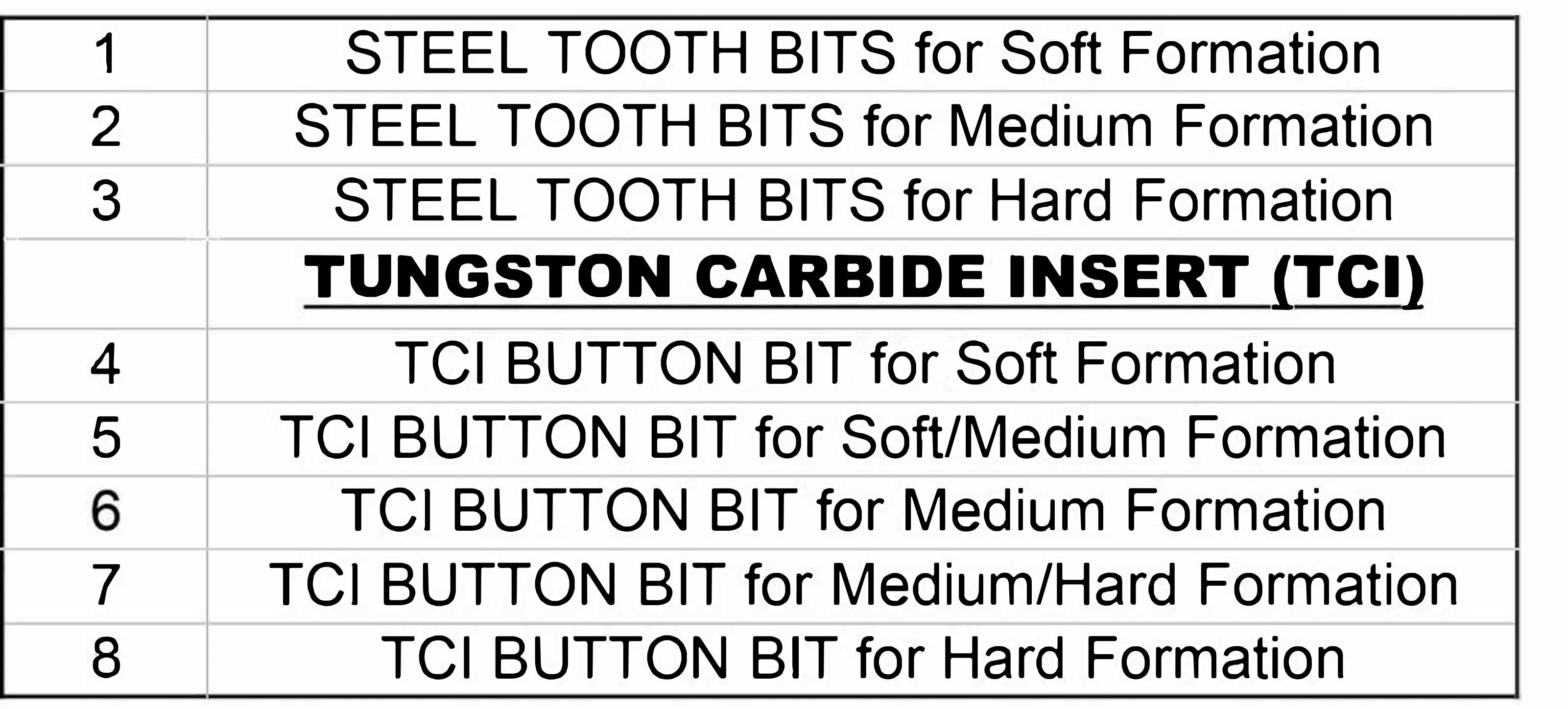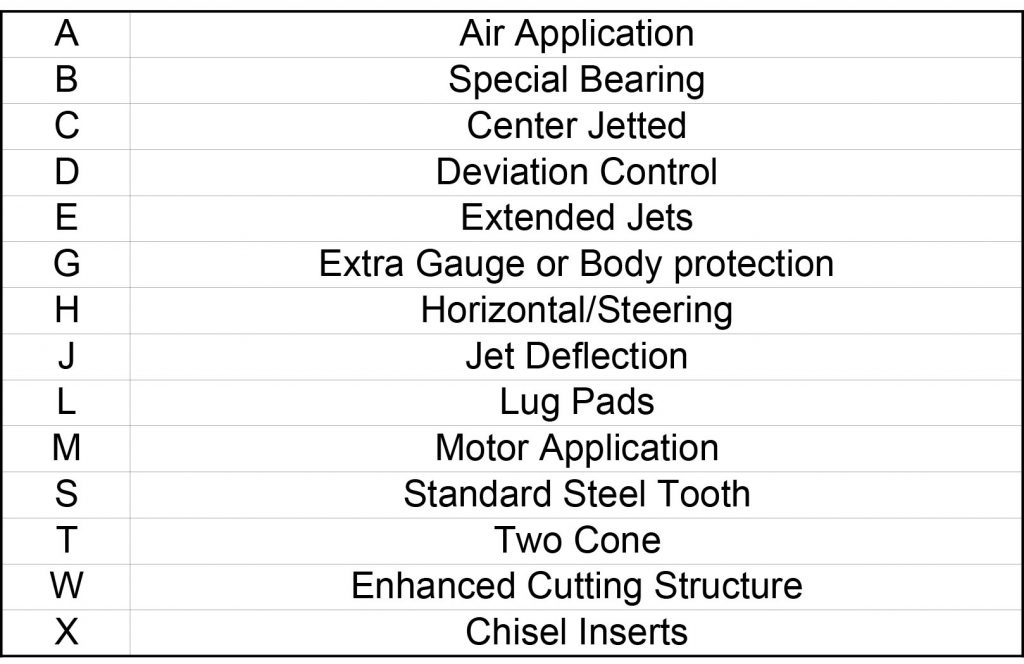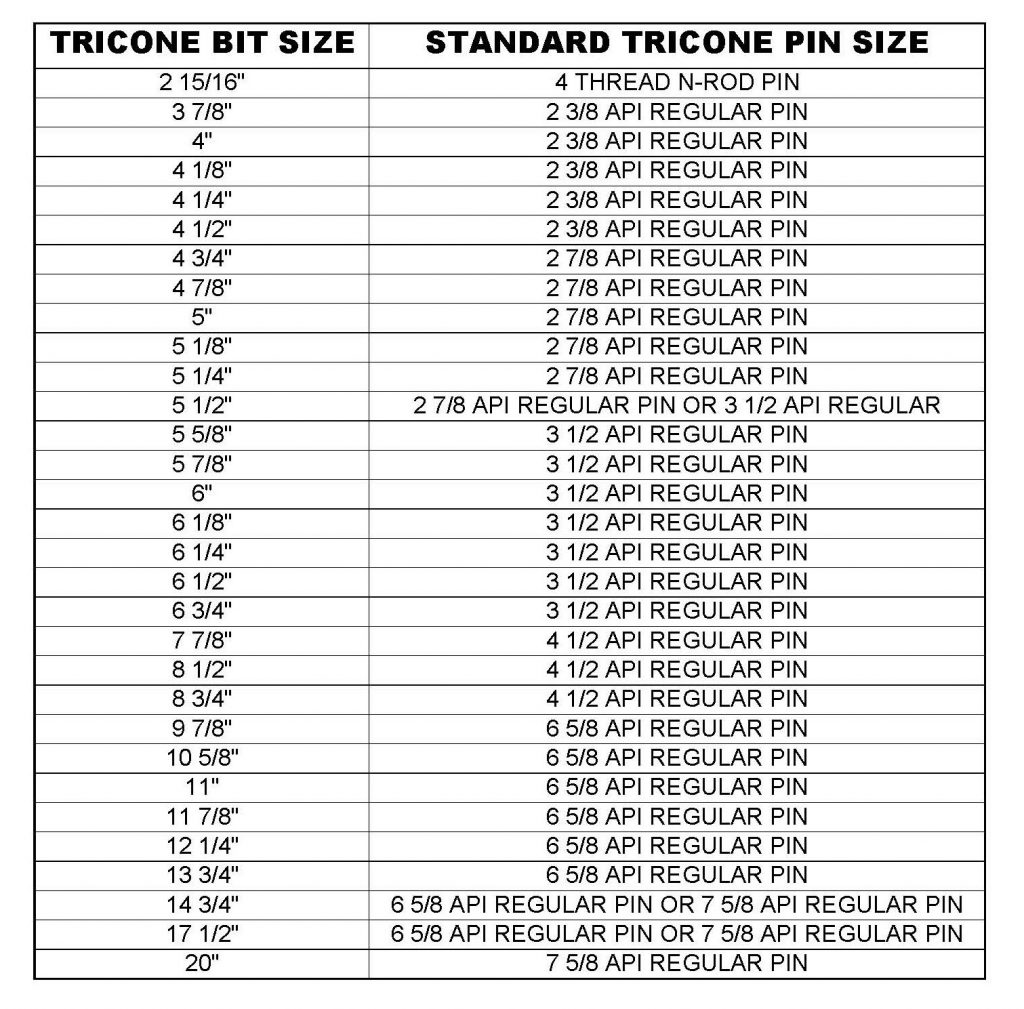Tricone Bits
Click here for a Complete Inventory of NDS’s New Stock Tricones.
NDS Drilling Supply, Inc. stocks a complete line Tricone bits consisting of new and retip bits as well as both steel tooth and carbide button bits.
Some brands include: Varel, Throop, Thompson, Smith, Baker Hughes, Focus and Reed.
Here are some of the sizes we stock:
|
|
|
|
|
|
|
|
HOW TO READ IADC CODES FOR TRICONE DRILL BITS
1st Digit
PLEASE NOTE THE FIRST DIGIT DETERMINES FORMATION HARDNESS. THE SECOND DIGIT IS ONLY A FURTHER BREAKDOWN WITHIN THE FIRST DIGITS FORMATION. FOR EXAMPLE, IADC CODE OF 311, 321, 331 ARE ALL HARD FORMATION BITS.
2ND DIGIT Formation
3rd digit Bearing and Seal Type
The first digit represents the hardness of rock formation the Tricone drilling bit buttons or teeth are best suited for.
Every drill bit is designed for a certain type of rock formation, ranked according to hardness.
The bit is assigned a number between 1 and 8 indicating the type of rock the teeth or buttons of a drilling bit are designed for:
1, 2 and 3: Indicate a steel tooth. 1 is engineered for soft rock formations, 2 for medium formations, and 3 for hard formations.
4, 5, 6, 7, and 8: Indicates a tungsten carbide insert (TCI).
Within this category 4 is designated for the softer formations, with 8 representing the hardest formations.
The second digit represents further rock formation information.
Regardless of tooth type, the second digit takes into account all factors of the bit and ranks the rock formations the drilling bit is best suited for on a scale from 1 to 4. 1 represents soft formations going up to 4 representing the hardest formations.
The third digit represents the bearing type of the Tricone Drilling Bit.
For Example, Tricone Drilling Bits use a different bearing depending on the type of material to be drilled.
1, 2 and 3: are for roller bearings. 1 is for standard roller bearings, 2 is for air cooled bearings, and 3 is for open bearing with gauge protection.
4 and 5: sealed roller bearings. 4 is for standard sealed roller bearings, and 5 is for a sealed roller bearing with gauge protection.
6 and 7: sealed journal bearings. 6 is for a standard sealed journal bearing, and 7 is for a sealed journal bearing with gauge protection.
The fourth digit is a letter indicating the special properties of the Tricone Drilling Bit.
In addition to the buttons, intended rock formations, and bearings used, Tricone drill bits can have numerous other special properties:
A – Air Application
B – Special Bearing
C – Center Jetted
D – Deviation Control
E – Extended Jets
G – Extra Gauge or Body protection
H – Horizontal/Steering
J – Jet Deflection
L – Lug Pads
M – Motor Application
S – Standard Steel Tooth
T – Two Cone
W – Enhanced Cutting Structure
X – Chisel Inserts
Listed below are many Tricone bit sizes and their corresponding pin size.
SOFT FORMATION TRICONE BIT
The 111 IADC rock bit is designed for rapid penetration in formations having a low compressive strength and high drillability, such as clays, sand, soft shales, red beds, salt, and soft sandstone. The long, widely spaced teeth are interfitted in such a manner so as to provide a twisting-tearing action that is so essential in the soft unconsolidated formations. Lighter drilling weights between 2,000 to 4,500 pounds per inch of bit diameter and faster rotary speeds of 70 to 120 RPM are usually employed with these efficient bits.
MEDIUM FORMATION TRICONE BIT
The 211 IADC rock bit is designed to drill formations having compressive strength of a magnitude somewhat greater than that noted in the 111 rock bit. Formations classified as medium hard to hard non-abrasive are the best suited for the 211, such as formations are hard shale, dolomite lime, hard anhydrite, slate and soft limestone. Cutter teeth are not as widely spaced or deeply cut as in the 111 rock bit. They combine twisting-tearing action with chipping-crushing action necessary for fast cutting and longer life through the relatively harder formations. The weight used on this bit is usually between 3,000 to 6,000 pounds per inch of bit diameter and rotary speeds between 45 to 85 RPM.
HARD FORMATION TRICONE BIT
The 321 IADC rock bit is designed especially to drill in hard, semi-abrasive formations, such as hard abrasive sand, hard tough shales, conglomerated, medium hard lime rock and chert streaks. The closely spaced teeth give the 321 a chipping-crushing action with sufficient twisting-tearing action to effectively dislodge the cuttings from the bottom hole surface. Exceptionally sturdy sections along with maximum bearing strength are designed to withstand heavy drilling weights. Slower rotary speeds around 35 to 75 RPM and drilling weight of 3,500 to 6,500 pounds per inch of bit diameter is recommended.
TUNGSTEN CARBIDE INSERT TRICONE BITS
SOFT TO MEDIUM SOFT FORMATION TRICONE BIT
NDS offers the 5-2-1 design for efficient drilling of soft to medium formations such as shale, red bed, limestone and other strata of low compressive strength with hard streaks or abrasive properties. This design employs a maximum offset and features all chisel shaped tungsten carbide inserts which are spaced slightly farther apart than normal to insure the highest possible rate of penetration. Ample hard facing on the shirttail provides maximum protection against abrasion and insures the longest possible bearing life. Suggested operating weights are 2,500 to 4,000 pounds per inch of bit diameter with corresponding rotary speeds of 50 to 80 RPM.
MEDIUM HARD FORMATION TRICONE BIT
The 6-3-1 is designed for medium hard formations that are semi-abrasive such as hard, sandy limestone, shale, dolomite and limestone with cherty streaks. This design features conical shaped tungsten carbide inserts on the gage rows to inhibit gage wear and chisel shaped inserts on the inner rows to get maximum penetration. Gouging/scraping action is provided by cone offset. Ample hard facing on the shirttail provides maximum protection against abrasion and insures the longest possible bearing life. Suggested operating weights are 3,000 to 6,000 pounds per inch bit diameter with corresponding rotary speeds of 40 to 70 RPM. Near the bit stabilization is recommended for maximum bit life.
MEDIUM HARD TO HARD FORMATION TRICONE BIT
The 7-4-1 features a minimum offset cutting structure design and all dome shaped tungsten carbide inserts. It is designed to drill hard and abrasive formations such as quartzite, granite, cherty iron ores, and copper porphyry. As with other NDS bit designs, this design features shirttail hard facing for maximum resistance to bearing wear. The drilling weights should range from 5,000 to 8,000 pounds per inch of bit diameter. As drilling weights are increased the rotational speed, which ranges from 30 to 60 RPM, should be decreased. Near the bit stabilization is highly recommended for maximum bit life, and pull down drills should be equipped with shock absorbers.





